brake light CHEVROLET CAMARO 1967 1.G Chassis Workshop Manual
[x] Cancel search | Manufacturer: CHEVROLET, Model Year: 1967, Model line: CAMARO, Model: CHEVROLET CAMARO 1967 1.GPages: 659, PDF Size: 114.24 MB
Page 15 of 659
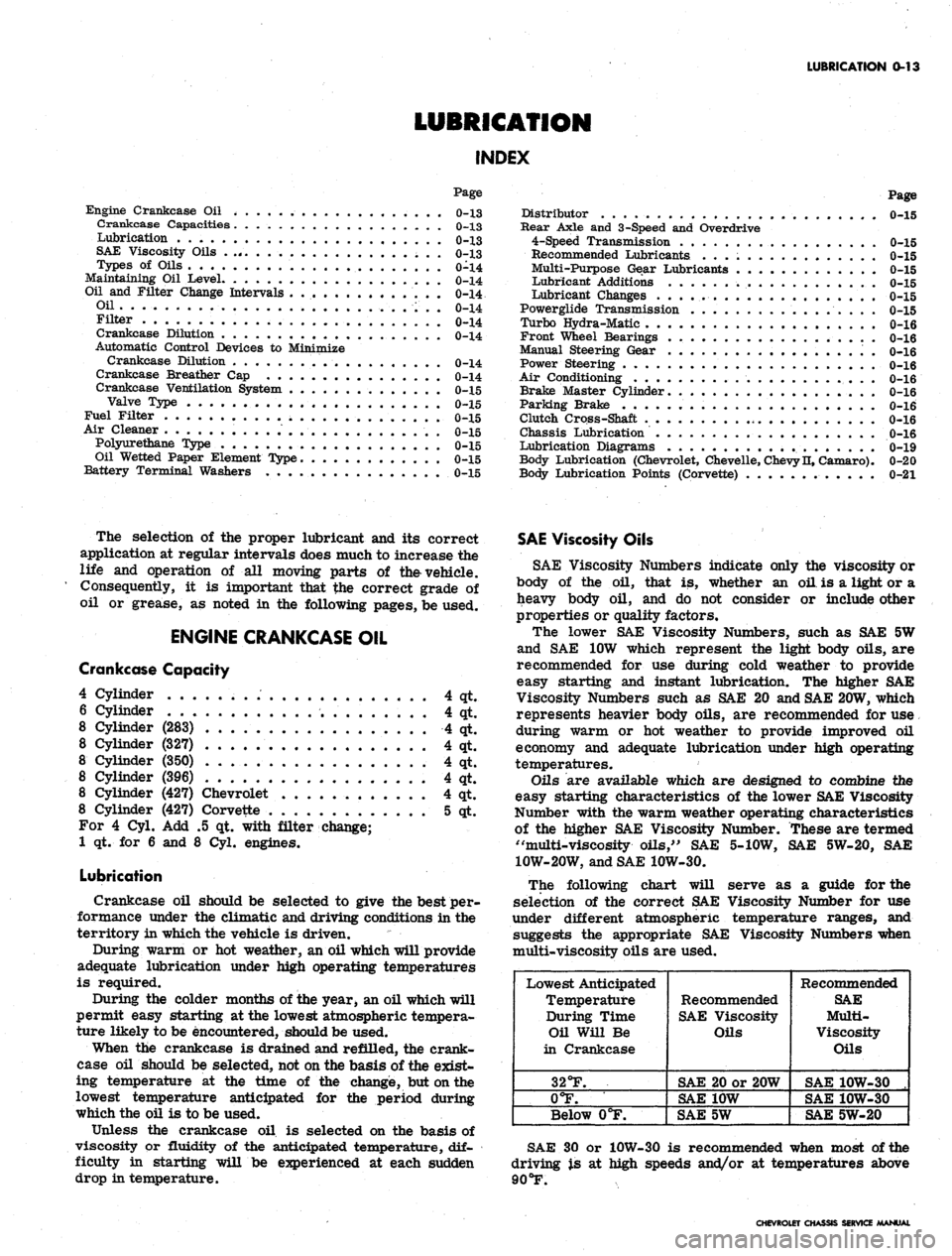
LUBRICATION 0-13
LUBRICATION
INDEX
Page
Engine Crankcase Oil . 0-13
Crankcase Capacities. . 0-13
Lubrication . ,
•
o-13
SAE Viscosity Oils 0-13
Types of Oils 0-14
Maintaining Oil Level 0-14
Oil and Filter Change Intervals 0-14
Oil.
. . ...:.. 0-14
Filter o-14
Crankcase Dilution . 0-14
Automatic Control Devices to Minimize
Crankcase Dilution 0-14
Crankcase Breather Cap 0-14
Crankcase Ventilation System 0-15
Valve Type 0-15
Fuel Filter 0-15
Air Cleaner . 0-15
Polyurethane Type 0-15
Oil Wetted Paper Element Type 0-15
Battery Terminal Washers 0-15
Page
Distributor 0-15
Rear Axle and 3-Speed and Overdrive
4-Speed Transmission 0-15
Recommended Lubricants 0-15
Multi-Purpose Gear Lubricants 0-15
Lubricant Additions 0-15
Lubricant Changes 0-15
Powerglide Transmission 0-15
Turbo Hydra-Matic 0-16
Front Wheel Bearings 0-16
Manual Steering Gear . . . . 0-16
Power Steering 0-16
Air Conditioning 0-16
Brake Master Cylinder. 0-16
Parking Brake 0-16
Clutch Cross-Shaft , 0-16
Chassis Lubrication 0-16
Lubrication Diagrams . . 0-19
Body Lubrication (Chevrolet, Chevelle, Chevy n, Camaro). 0-20
Body Lubrication Points (Corvette) . 0-21
The selection of the proper lubricant and its correct
application at regular intervals does much to increase the
life and operation of all moving parts of the vehicle.
Consequently, it is important that the correct grade of
oil or grease, as noted in the following pages, be used.
ENGINE CRANKCASE OIL
Crankcase Capacity
4 Cylinder 4 qt.
6 Cylinder 4 qt.
8 Cylinder (283) 4 qt.
8 Cylinder (327) 4 qt.
8 Cylinder (350) 4 qt.
8 Cylinder (396) 4 qt.
8 Cylinder (427) Chevrolet 4 qt.
8 Cylinder (427) Corvette 5 qt.
For 4 Cyl. Add .5 qt. with filter change;
1 qt. for 6 and 8 Cyl. engines.
Lubrication
Crankcase oil should be selected to give the best per-
formance under the climatic and driving conditions in the
territory in which the vehicle is driven.
During warm or hot weather, an oil which will provide
adequate lubrication under high operating temperatures
is required.
During the colder months of the year* an oil which will
permit easy starting at the lowest atmospheric tempera-
ture likely to be encountered, should be used.
When the crankcase is drained and refilled, the crank-
case oil should be selected, not on the basis of the exist-
ing temperature at the time of the change, but on the
lowest temperature anticipated for the period during
which the oil is to be used.
Unless the crankcase oil is selected on the basis of
viscosity or fluidity of the anticipated temperature, dif-
ficulty in starting will be experienced at each sudden
drop in temperature.
SAE Viscosity Oils
SAE Viscosity Numbers indicate only the viscosity or
body of the oil, that is, whether an oil is a light or a
heavy body oil, and do not consider or include other
properties or quality factors.
The lower SAE Viscosity Numbers, such as SAE 5W
and SAE 10W which represent the light body oils, are
recommended for use during cold weather to provide
easy starting and instant lubrication. The higher SAE
Viscosity Numbers such as SAE 20 and SAE 20W, which
represents heavier body oils, are recommended for use
during warm or hot weather to provide improved oil
economy and adequate lubrication under high operating
temperatures.
Oils are available which are designed to combine the
easy starting characteristics of the lower SAE Viscosity
Number with the warm weather operating characteristics
of the higher SAE Viscosity Number. These are termed
"multi-viscosity oils," SAE 5-10W, SAE 5W-20, SAE
10W-20W, and SAE 10W-30.
The following chart will serve as a guide for the
selection of the correct SAE Viscosity Number for use
under different atmospheric temperature ranges, and
suggests the appropriate SAE Viscosity Numbers when
multi-viscosity oils are used.
Lowest Anticipated
Temperature
During Time
Oil Will Be
in Crankcase
32°F.
0°F.
Below 0°F.
Recommended
SAE Viscosity
Oils
SAE 20 or 20W
SAE 10W
SAE 5W
Recommended
SAE
Multi-
Viscosity
Oils
SAE 10W-30 .
SAE 10W-30
SAE 5W-20
SAE 30 or 10W-30 is recommended when most of the
driving is at high speeds and/or at temperatures above
90
°F.
CHEVROLET CHASSIS SERVICE MANUAL
Page 23 of 659
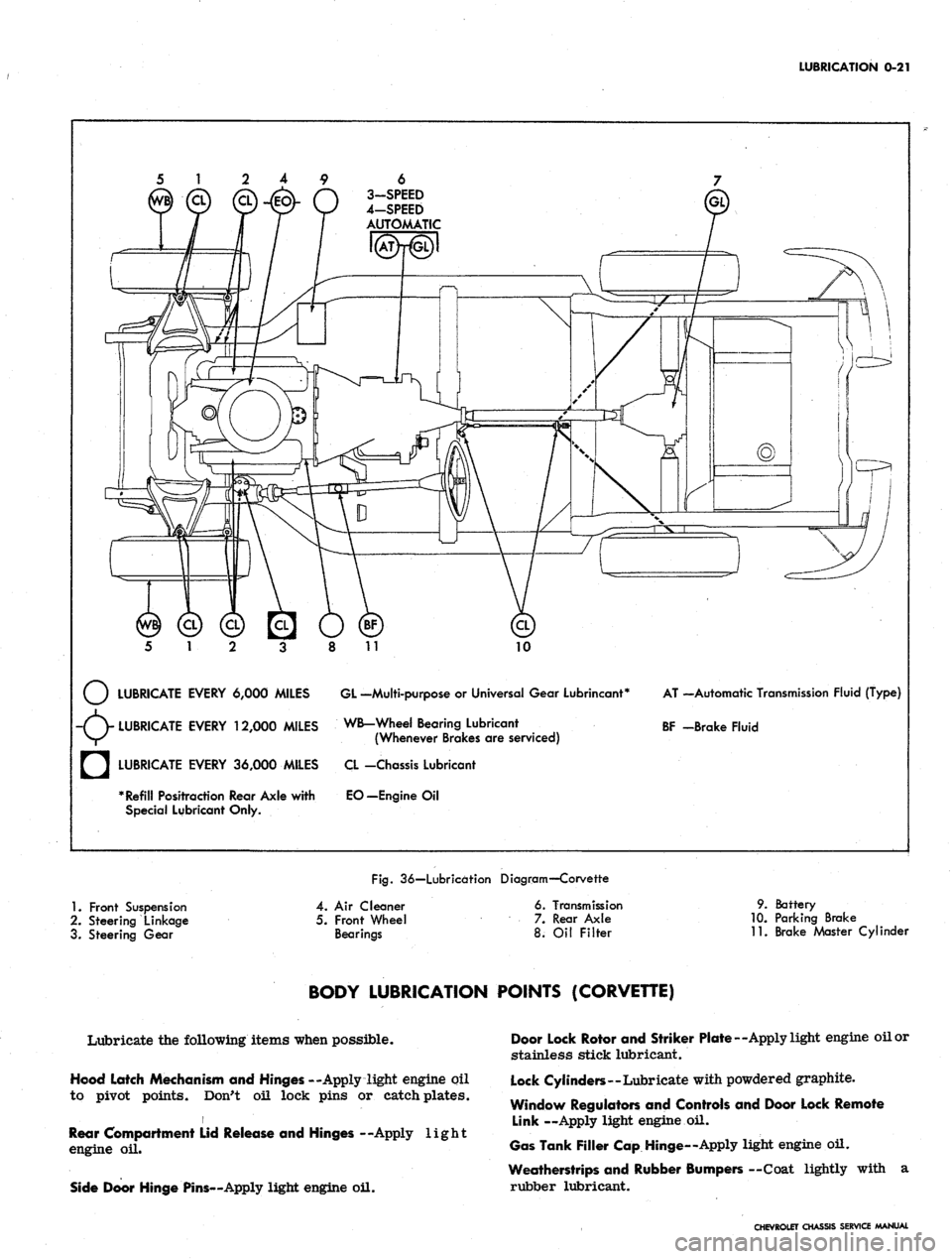
LUBRICATION
0-21
6
3-SPEED
4-SPEED
AUTOMATIC
10
LUBRICATE EVERY 6,000 MILES GL -Multi-purpose
or
Universal Gear Lubrincant*
-(V LUBRICATE EVERY 12,000 MILES WB-Wheel Bearing Lubricant
V/^ (Whenever Brakes
are
serviced)
AT —Automatic Transmission Fluid (Type)
BF -Brake Fluid
a
LUBRICATE EVERY 36,000 MILES
* Refill Positraction Rear Axle with
Special Lubricant Only.
CL -Chassis Lubricant
EO—Engine
Oil
Fig.
36—Lubrication Diagram—Corvette
1.
Front Suspension
2.
Steering Linkage
3. Steering Gear
4.
Air
Cleaner
5. Front Wheel
Bearings
6. Transmission
7. Rear Axle
8.
Oil
Filter
9. Battery
10.
Parking Brake
11.
Brake Master Cylinder
BODY LUBRICATION POINTS (CORVETTE)
Lubricate the following items when possible.
Hood Latch Mechanism and Hinges --Apply light engine oil
to pivot points. Don't oil lock pins or catch plates.
i
Rear Compartment Lid Release and Hinges --Apply light
engine
oil.
Side Door Hinge Pins—Apply light engine oil.
Door Lock Rotor and Striker Plate—Apply light engine oil or
stainless stick lubricant.
Lock Cylinders—Lubricate with powdered graphite.
Window Regulators and Controls and Door Lock Remote
Link —Apply light engine
oil.
Gas Tank Filler Cap Hinge—Apply light engine oil.
Weatherstrips and Rubber Bumpers —Coat lightly with
a
rubber lubricant.
CHEVROLET CHASSIS SERVICE MANUAL
Page 88 of 659

HEATER AND AIR CONDITIONING 1A-65
Fig.
92—Chevrolet Four-Season Ducts
Installation
Reverse
assembly.
the removal procedure to reinstall the duct
Left Outlet Duct
Removal
1.
Remove the two parking brake lever bracket to
dash brace attaching screws and move the lever and
cable so they will not interfere with the duct
removal.
2.
Remove the screw and lock washer attaching the duct
outer bracket to the hinge pillar support.
3.
Remove the screws and lock washers attaching the
duct assembly to the dash brace bracket.
4.
Carefully pull the outer end of the duct downward,
detaching the courtesy light from its bracket.
5. Loosen the screws clamping the outlet duct to dis-
tributor assembly flexible tubing at the outlet duct.
The outlet duct may now be removed from beneath
the instrument panel.
6. The duct extension assembly and the deflector as-
sembly may be removed, if desired, as seen in
Figure 95.
Installation
The duct assembly is installed by reversing the re-
moval instructions.
Center Outlet Duct
Removal
1.
Remove the right and left console trim panels.
2.
Remove the radio receiver.
3.
Remove the electric clock.
4.
Remove the knobs, nuts and bezels from the two
air conditioning controls above the clock, AIR COND.
PULL and COLD IN-HOT PULL.
5. Carefully pull the outlet duct and control cables
loose from the rear of the center console and work
it down and out from under the dash. The left hand
control cable runs through the left hand flexible
tubing and may be left in the tubing after it is dis-
engaged from the duct. The right hand control cable
must also be pulled from the duct assembly as the
duct is removed.
6. The center deflector barrel assembly may now be
removed if necessary. Snap off the hairpin clips to
remove the barrel and spacer washers.
Installation
Reverse the removal procedure for installation.
AIR DISTRIBUTOR ASSEMBLY
Removal
1.
Drain the cooling system radiator.
2.
Remove the heater hoses from the core pipes and
remove the cover attaching nuts and cover surround-
ing the core pipes.
3.
Remove the glove compartment assembly and the
glove compartment door.
NOTE:.
See "Section 1 - Body" for removal
and installation of body items.
4.
Remove the right kick pad.
5. Remove the right and left center console trim panels.
6. Remove the radio receiver assembly.
7. Remove the defroster duct.
CHEVROLET CHASSIS SERVICE MANUAL
Page 172 of 659
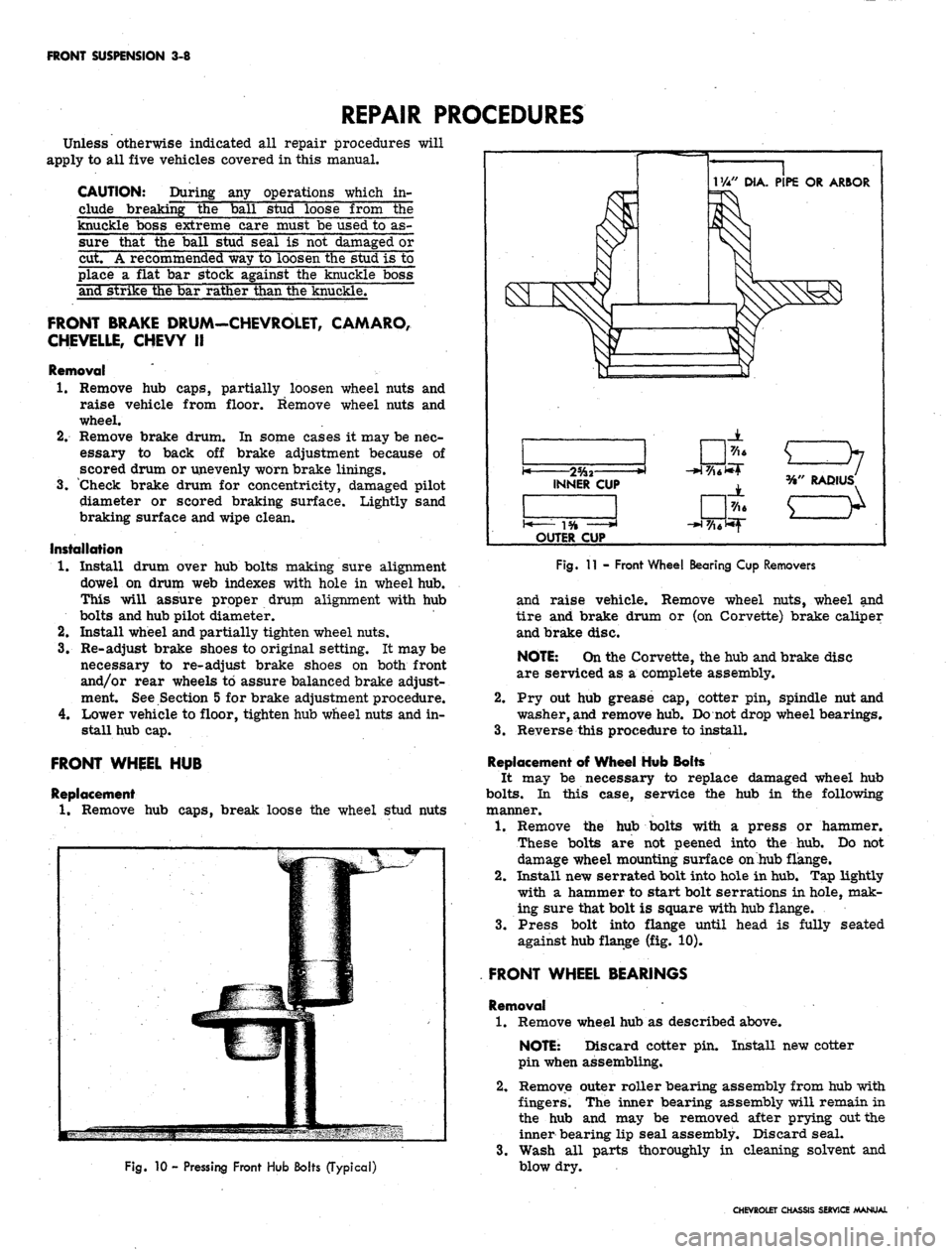
FRONT SUSPENSION 3-8
REPAIR PROCEDURES
Unless otherwise indicated all repair procedures will
apply to all five vehicles covered in this manual.
CAUTION: During any operations which in-
clude breaking the ball stud loose from the
knuckle boss extreme care must be used to as-
sure that the ball stud seal is not damaged or
cut. A recommended way to loosen the stud is to
place a flat bar stock against the knuckle boss
and strike the bar rather than the knuckle.
FRONT BRAKE DRUM-CHEVROLET, CAMARO,
CHEVELLE, CHEVY It
Removal
1.
Remove hub caps, partially loosen wheel nuts and
raise vehicle from floor. Remove wheel nuts and
wheel.
2.
Remove brake drum. In some cases it may be nec-
essary to back off brake adjustment because of
scored drum or unevenly worn brake linings.
3.
Check brake drum for concentricity, damaged pilot
diameter or scored braking surface. Lightly sand
braking surface and wipe clean.
Installation
1.
Install drum over hub bolts making sure alignment
dowel on drum web indexes with hole in wheel hub.
This will assure proper drum alignment with hub
bolts and hub pilot diameter.
2.
Install wheel and partially tighten wheel nuts.
3.
Re-adjust brake shoes to original setting. It may be
necessary to re-adjust brake shoes on both front
and/or rear wheels to assure balanced brake adjust-
ment. See Section 5 for brake adjustment procedure.
4.
Lower vehicle to floor, tighten hub wheel nuts and in-
stall hub cap.
FRONT WHEEL HUB
Replacement
1.
Remove hub caps, break loose the wheel stud nuts
VM" DIA. PIPE OR ARBOR
>l
INNER CUP
OUTER CUP
JL
RADIUS
e^
Fig.
10 - Pressing Front Hub Bolts (Typical)
Fig.
11 - Front Wheel Bearing Cop Removers
and raise vehicle. Remove wheel nuts, wheel and
tire and brake drum or (on Corvette) brake caliper
and brake disc.
NOTE:
On the Corvette, the hub and brake disc
are serviced as a complete assembly.
2.
Pry out hub grease cap, cotter pin, spindle nut and
washer,
and
remove hub. Do not drop wheel bearings.
3.
Reverse this procedure to install.
Replacement of Wheel Hub Bolts
It may be necessary to replace damaged wheel hub
bolts.
In this case, service the hub in the following
manner.
1.
Remove the hub bolts with a press or hammer.
These bolts are not peened into the hub. Do not
damage wheel mounting surface on hub flange.
2.
Install new serrated bolt into hole in
hub.
Tap lightly
with a hammer to start bolt serrations in hole, mak-
ing sure that bolt is square with hub flange.
3.
Press bolt into flange until head is fully seated
against hub flange (fig. 10).
FRONT WHEEL BEARINGS
Removal '
1.
Remove wheel hub as described above.
NOTE: Discard cotter pin. Install new cotter
pin when assembling.
2.
Remove outer roller bearing assembly from hub with
fingers. The inner bearing assembly will remain in
the hub and may be removed after prying out the
inner bearing lip seal assembly. Discard seal.
3.
Wash all parts thoroughly in cleaning solvent and
blow dry.
CHEVROLET CHASSIS SERVICE MANUAL
Page 176 of 659

FRONT SUSPENSION 3-12
2.
Remove forward nut, retainer and rubber bushing
from front end of strut rod.
3.
Remove two nuts from strut rod to lower control arm
bolts and remove bolts and washers.
4.
Withdraw strut rod from bracket.
5. Remove remaining rubber bushing, retainer, sleeve
and nut from strut rod.
6. Inspect rubber bushings for aging and replace if
necessary. *•
Installation
1.
Screw rear nu$ on forward end of rod and position it
approximately 3/4" from end of threads. Install
rear retainer, sleeve and bushing on rod so raised
pilot diameter faces forward.
2.
Insert strut rod in bracket so pilot diameter on bush-
ing pilots in hole in bracket. Install forward bushing
on sleeve so raised pilot diameter faces rear to
enter hole in bracket, then install forward retainer
and nut on rod.
3.
Attach strut rod to top of lower control arm with two
bolts,
washers and nuts.
4.
Lower vehicle to floor, check caster and camber
angles and adjust where necessary. Torque nuts as
shown in Specifications.
FRONT SPRING
Chevrolet
Removal
1.
With an open end wrench hold the shock absorber
upper stem from turning, and then remove the upper
stem retaining nut, retainer and rubber grommet.
I IVi" rVi"i
\>. j ii
>
I
5'4
s
WOOD
BLOCK
USED
WITH
CHEVROLET
ONLY
Fig.
19
- Spring Removal Tools - Chevrolet, Chevelle and Comoro
2.
With the car supported by the frame so that the con-
trol arms hang free, remove the wheel and tire as-
sembly (replace one wheel nut to retain the brake
drum),
shock absorber, stabilizer bar to lower con-
trol arm link, strut rod to lower control arm attach-
ing, nuts, bolts and lock washers and tie rod end.
3.
Scribe the position of the inner pivot camber adjust-
ing cam bolt and then remove the nut, lock washer
and outer cam.
4.
Install a steel bar (fabricated as shown in Figure 19)
through the shock abosrber mounting hole in the
lower control arm so that the notch seats over the
bottom spring coil and the bar extends inboard and
under the inner bushing. Fit a 5" wood block (See
Figure 19) between the bar and the bushing as shown
in Figure 20.
5.
With suitable jack or hoist, lift up slightly on the end
of the bar to remove the tension from the inner pivot
cam bolt, which can then be removed.
Fig.
18-Strut Rod
Pig. 20 - Front Spring Removal - Chevrolet
CHEVROLET CHASSIS SERVICE MANUAL
Page 177 of 659
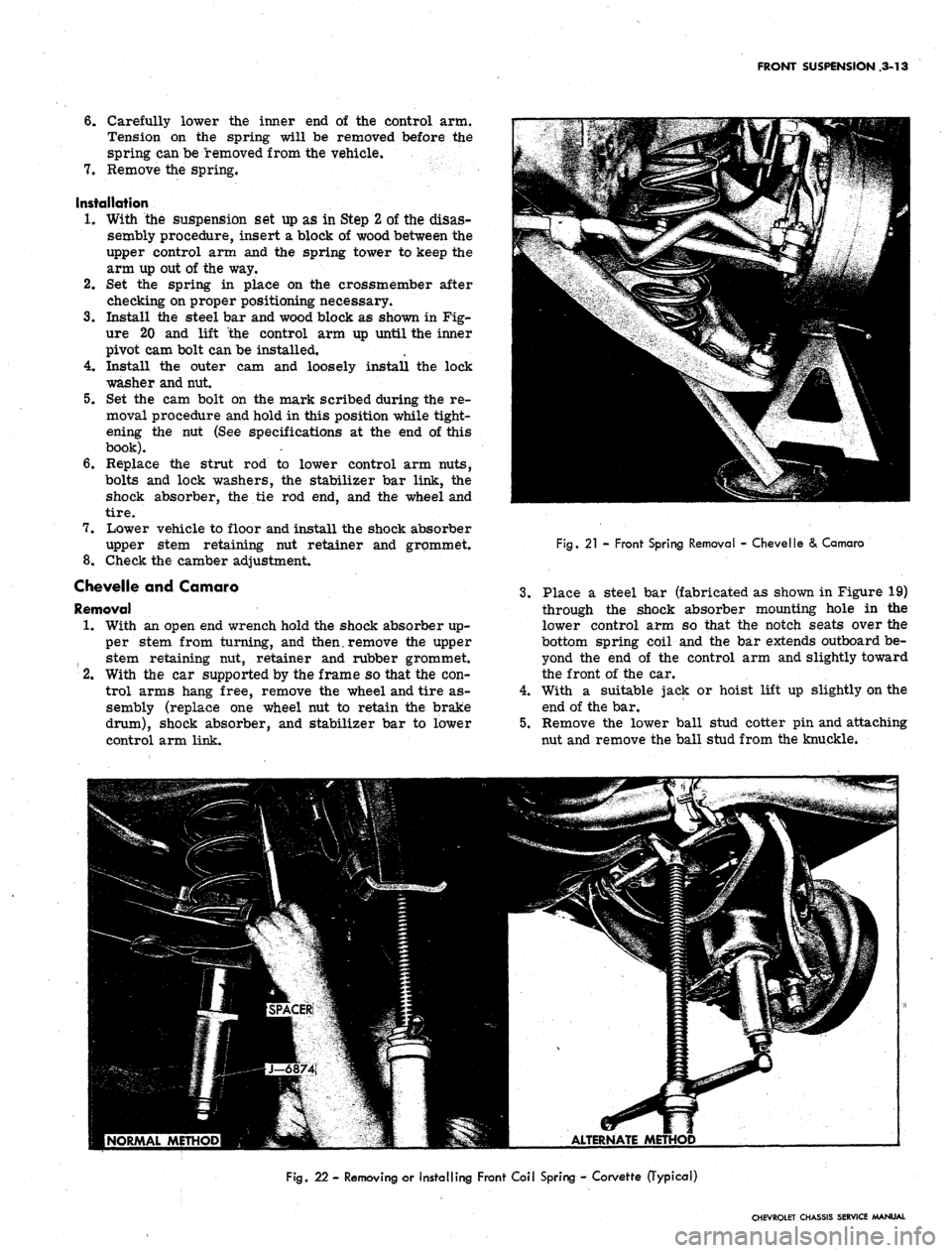
FRONT SUSPENSION ,3-13
6. Carefully lower the inner end of the control arm.
Tension on the spring will be removed before the
spring can be removed from the vehicle.
7.
Remove the spring.
Installation
1.
With the suspension set up as in Step 2 of the disas-
sembly procedure, insert a block of wood between the
upper control arm and the spring tower to keep the
arm up out of the way.
2.
Set the spring in place on the crossmember after
checking on proper positioning necessary.
3.
Install the steel bar and wood block as shown in Fig-
ure 20 and lift the control arm up until the inner
pivot cam bolt can be installed. ,
4.
Install the outer cam and loosely install the lock
washer and nut
5.
Set the cam bolt on the mark scribed during the re-
moval procedure and hold in this position while tight-
ening the nut (See specifications at the end of this
book).
6. Replace the strut rod to lower control arm nuts,
bolts and lock washers, the stabilizer bar link, the
shock absorber, the tie rod end, and the wheel and
tire.
7.
Lower vehicle to floor and install the shock absorber
upper stem retaining nut retainer and grommet.
8. Check the camber adjustment.
Chevelle and Camaro
Removal
1.
With an open end wrench hold the shock absorber up-
per stem from turning, and then, remove the upper
stem retaining nut, retainer and rubber grommet.
2.
With the car supported by the frame so that the con-
trol arms hang free, remove the wheel and tire as-
sembly (replace one wheel nut to retain the brake
drum),
shock absorber, and stabilizer bar to lower
control arm link.
4.
5.
Fig.
21 - Front Spring Removal - Chevelle & Camaro
Place a steel bar (fabricated as shown in Figure 19)
through the shock absorber mounting hole in the
lower control arm so that the notch seats over the
bottom spring coil and the bar extends outboard be-
yond the end of the control arm and slightly toward
the front of the car.
With a suitable jack or hoist lift up slightly on the
end of the bar.
Remove the lower ball stud cotter pin and attaching
nut and remove the ball stud from the knuckle.
ALTERNATE METHOD
Fig.
22 - Removing or Installing Front Coil Spring - Corvette (Typical)
CHEVROLET CHASSIS SERVICE MANUAL
Page 185 of 659
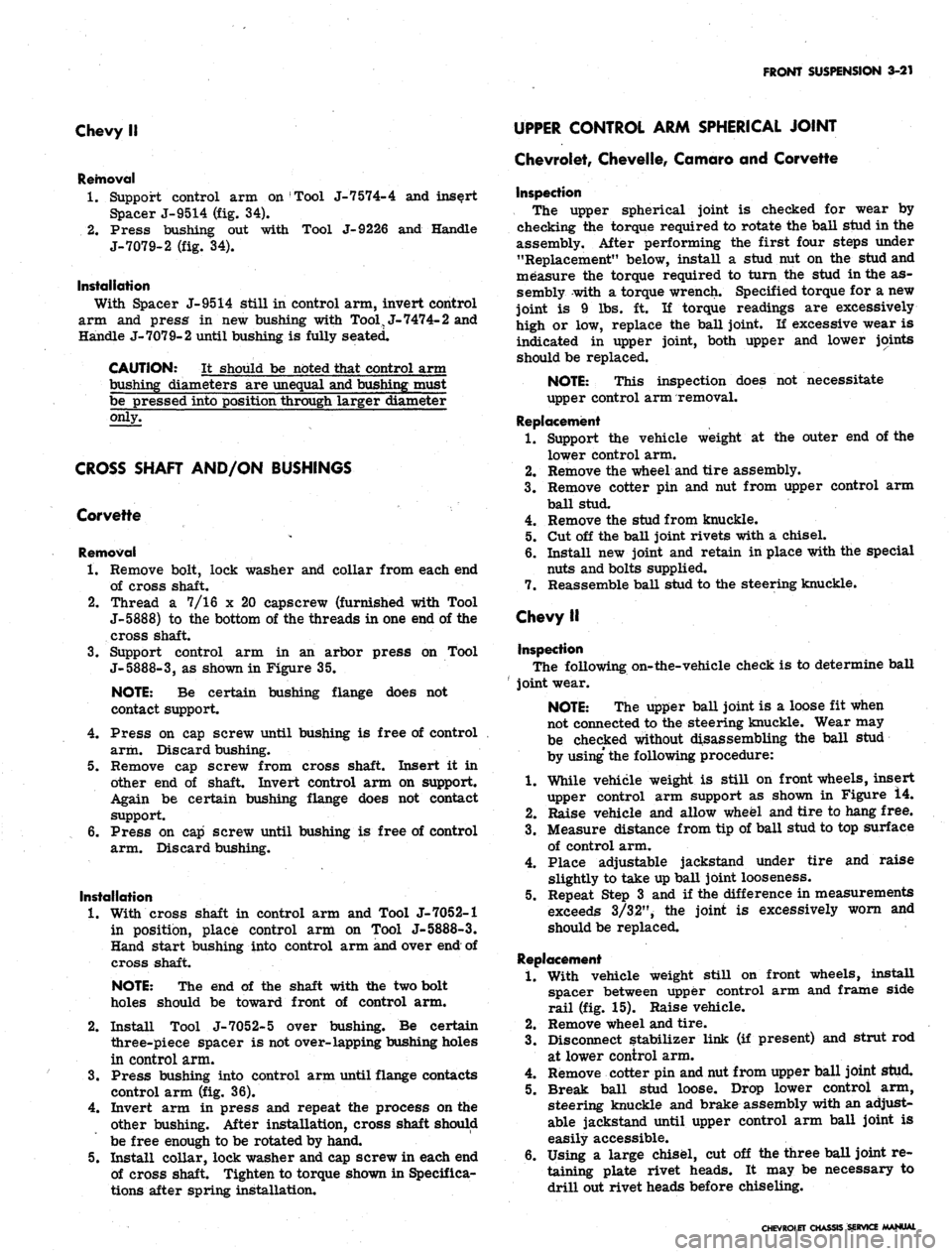
FRONT SUSPENSION 3-21
Chevy II
Removal
1.
Support control arm on Tool J-7 574-4 and insert
Spacer J-9514 (fig. 34).
2,
Press bushing out with Tool J-9226 and Handle
J-7079-2 (fig. 34).
Installation
With Spacer J-9514 still in control arm, invert control
arm and press in new bushing with Tool, J-7474-2 and
Handle J-7079-2 until bushing is fully seated.
CAUTION: It should be noted that control arm
bushing diameters are unequal and bushing must
be pressed into position through larger diameter
only.
CROSS SHAFT AND/ON BUSHINGS
Corvette
Removal
1.
Remove bolt, lock washer and collar from each end
of cross shaft.
2.
Thread a 7/16 x 20 capscrew (furnished with Tool
J-5888) to the bottom of the threads in one end of the
cross shaft.
3.
Support control arm in an arbor press on Tool
J-5888-3,
as shown in Figure 35.
NOTE:
Be certain bushing flange does not
contact support.
4.
Press on cap screw until bushing is free of control
arm. Discard bushing.
5. Remove cap screw from cross shaft. Insert it in
other end of shaft. Invert control arm on support.
Again be certain bushing flange does not contact
support.
6. Press on cap screw until bushing is free of control
arm. Discard bushing.
Installation
1.
With cross shaft in control arm and Tool J-7052-1
in position, place control arm on Tool J-5888-3.
Hand start bushing into control arm and over end of
cross shaft.
NOTE:
The end of the shaft with the two bolt
holes should be toward front of control arm.
2.
Install Tool J-7052-5 over bushing. Be certain
three-piece spacer is not over-lapping bushing holes
in control arm.
3.
Press bushing into control arm until flange contacts
control arm (fig. 36).
4.
Invert arm in press and repeat the process on the
other bushing. After installation, cross shaft should
be free enough to be rotated by hand.
5. Install collar, lock washer and cap screw in each end
of cross shaft. Tighten to torque shown in Specifica-
tions after spring installation.
UPPER CONTROL ARM SPHERICAL JOINT
Chevrolet, Chevelle, Comoro and Corvette
Inspection
The upper spherical joint is checked for wear by
checking the torque required to rotate the ball stud in the
assembly. After performing the first four steps under
"Replacement" below, install a stud nut on the stud and
measure the torque required to turn the stud in the as-
sembly with a torque wrench. Specified torque for a new
joint is 9 lbs. ft. If torque readings are excessively
high or low, replace the ball joint. If excessive wear is
indicated in upper joint, both upper and lower joints
should be replaced.
NOTE:
This inspection does not necessitate
upper control arm removal.
Replacement
1.
Support the vehicle weight at the outer end of the
lower control arm.
2.
Remove the wheel and tire assembly.
3.
Remove cotter pin and nut from upper control arm
ball stud.
4.
Remove the stud from knuckle.
5. Cut off the ball joint rivets with a chisel.
6. Install new joint and retain in place with the special
nuts and bolts supplied.
7. Reassemble ball stud to the steering knuckle.
Chevy II
Inspection
The following on-the-vehicle check is to determine ball
joint wear.
NOTE:
The upper ball joint is a loose fit when
not connected to the steering knuckle. Wear may
be checked without disassembling the ball stud
by
using'
the following procedure:
1.
While vehicle weight is still on front wheels, insert
upper control arm support as shown in Figure 14.
2.
Raise vehicle and allow wheel and tire to hang free.
3.
Measure distance from tip of ball stud to top surface
of control arm.
4.
Place adjustable jackstand under tire and raise
slightly to take up ball joint looseness.
5. Repeat Step 3 and if the difference in measurements
exceeds 3/32", the joint is excessively worn and
should be replaced.
Replacement
1.
With vehicle weight still on front wheels, install
spacer between upper control arm and frame side
rail (fig. 15). Raise vehicle.
2.
Remove wheel and tire.
3.
Disconnect stabilizer link (if present) and strut rod
at lower control arm.
4.
Remove cotter pin and nut from upper ball joint stud.
5. Break ball stud loose. Drop lower control arm,
steering knuckle and brake assembly with an adjust-
able jackstand until upper control arm ball joint is
easily accessible.
6. Using a large chisel, cut off the three ball joint re-
taining plate rivet heads. It may be necessary to
drill out rivet heads before chiseling.
CHEVROLET CHASSIS SERVICE MANUAL
Page 197 of 659

REAR SUSPENSION AND DRIVE LINE 4-7
tioned vertically in the torque arm before ap-
plying pressure to the puller screw.
5.
Remove shim and bearing spacer from spindle
support.
6. Note size of shim used. If dial indicator reading
was more than
.008",
select a shim thinner by the
amount needed to bring end play within limits. If
dial indicator reading was less than
.001",
select a
shim thicker by the amount needed to bring end play
within limits.
NOTE: Shims are available in thicknesses from
.097"
to .148" in increments of
.003".
EXAMPLE: Bearing end play reading obtained
on dial indicator was
.011",
.003" over limit.
Bearing shim removed from spindle measures
.145".
New shim installed measures .139", .006"
smaller. End play is now decreased by .006" and
is
.005",
which is within the .001" to .008" limit.
7.
After determining shim thickness, install bearing
spacer and shim on spindle. Position spindle in
spindle support.
8. Press inner bearing race and roller assembly on
spindle as follows.
a. Position Tool J-4731 over spindle and against
bearing inner race.
b.
Position washer and spindle nut on spindle and
proceed to tighten nut until bearing is forced on
spindle sufficiently to allow spindle drive flange
to be installed (fig. 13). Remove spindle nut,
washer and Tool
J-4731.
Discard nut and use a
new one for final assembly.
9. Position drive flange over spindle, making sure
flange is aligned with spindle splines. Install washer
Fig.
13—Installing Drive Spindle to Support (Corvette)
and nut on spindle then tighten nut to specifications
and install cotter pin. If specified torque does not
permit cotter pin insertion, tighten nut to next flat.
10.
Seat spindle support outer seal in bore by using
screw driver, or other suitable tool, to press against
metal portion of seal.
11.
Install brake disc and caliper. Refer to Section 5
for details of brake disc and caliper installation.
12.
Install axle drive shaft, wheel and tire assembly,
adjust camber cam to original position and torque
all components to specifications.
COMPONENT PARTS REPLACEMENT
(Chevrolet, Chevelle, Chevy II and Camaro)
COIL SPRING
Chevrolet
Removal
To remove either or both rear coil springs proceed
as follows.
1.
Raise rear of vehicle and place jack stands under
frame. Support vehicle weight at rear, using either
a jack or post of twin-post hoist under axle.
2.
Remove both rear wheels from vehicle.
3.
With the car supported as in Step 1, so that the rear
springs are compressed by weight of vehicle; per-
form the following:
a. Disconnect both rear shock absorbers from the
anchor pin lower attachment.
b.
Loosen the upper control arm(s) rear pivot bolt
(do not remove the nut).
C. Loosen both the left and the right lower control
arm rear attachment (do not disconnect from axle
brackets).
d. Remove the rear suspension tie rod from the
stud on the axle tube.
4.
At the lower seat of both rear coil springs, slightly
loosen the nut on the bolt that retains the spring and
seat to the control arm. When the nut has been
backed off the maximum permissible, all threads of
the nut should still be engaged on the bolt.
CAUTION: Under ,no condition should the nut,
at this time, be removed from the bolt in the
seat of either spring.
5.
Slowly lower the support (jack or hoist post) that has
been in place under the rear axle, thereby allowing
the axle to swing down, carrying the springs out of
their upper seat and providing access for spring
removal.
6. Remove the lower seat attaching parts from each
spring, then remove the springs from the vehicle
(fig. 14).
Installation
1.
Position the springs in their upper seat so that end
of top coil is 3/8" ± 1/8" from end of stop. Install
the lower seat parts on the control arm, with the nut
finger tight on the spring retainer bolt.
NOTE: Omit the lock washer under the special
high carbon bolt, so that sufficient bolt thread
will be available to start the nut. The lock
washers will be installed later (in Step 4).
2.
By alternately raising the axle slightly and then
re-snugging the nut on each spring lower seat bolt,
move the axle upward until vehicle weight is fully
CHEVROLET CHASSIS SERVICE MANUAL
Page 214 of 659
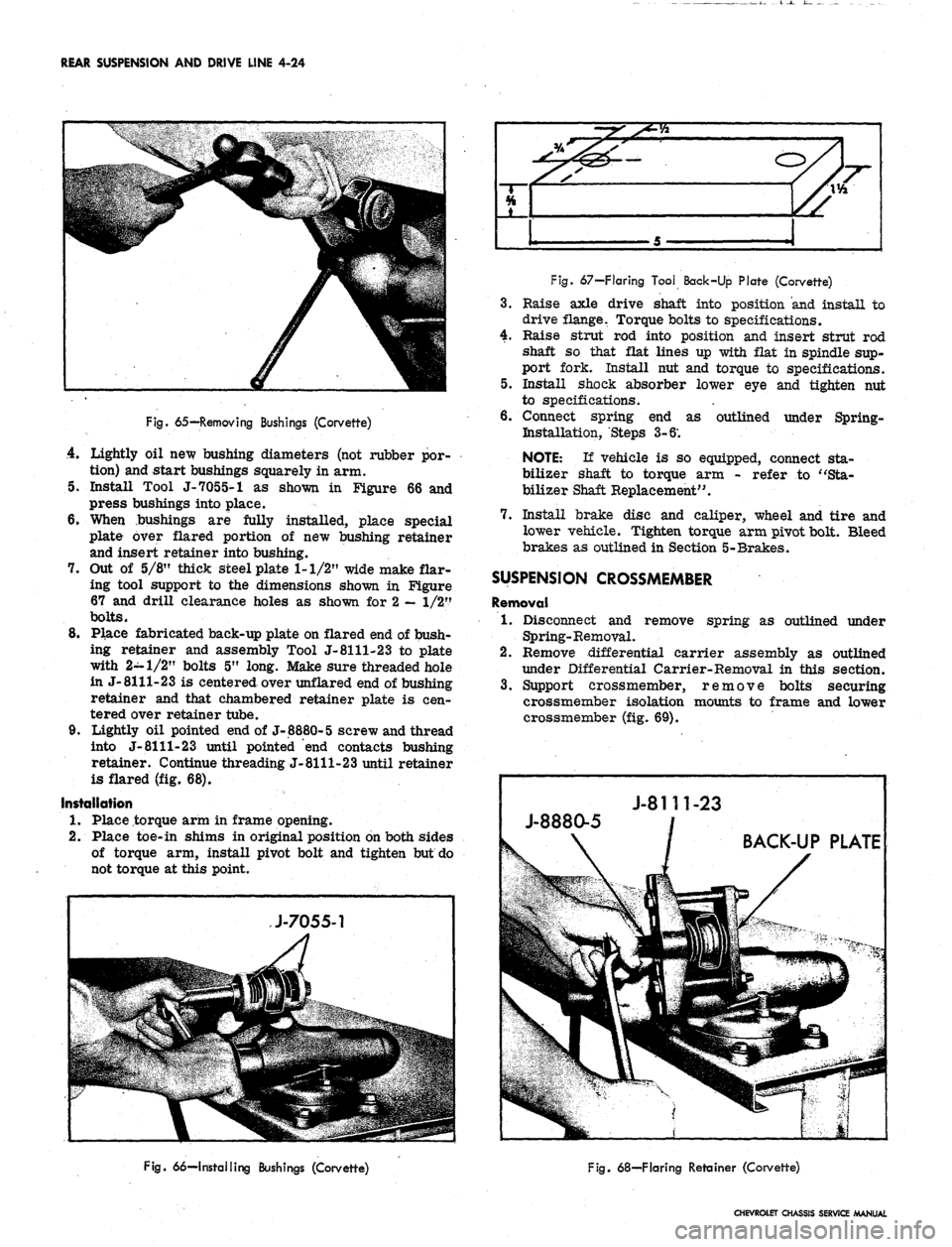
REAR SUSPENSION AND DRIVE LINE 4-24
4
i*
5
Fig.
65—Removing Bushings (Corvette)
4.
Lightly oil new bushing diameters (not rubber por-
tion) and start bushings squarely in arm.
5. Install Tool J-7055-1 as shown in Figure 66 and
press bushings into place.
6. When bushings are fully installed, place special
plate over flared portion of new bushing retainer
and insert retainer into bushing.
7. Out of 5/8" thick steel plate 1-1/2" wide make flar-
ing tool support to the dimensions shown in Figure
67 and drill clearance holes as shown for 2
—
1/2"
bolts.
8. Place fabricated back-up plate on flared end of bush-
ing retainer and assembly Tool J-8111-23 to plate
with 2-1/2" bolts 5" long. Make sure threaded hole
in J-8111-23 is centered over unflared end of bushing
retainer and that chambered retainer plate is cen-
tered over retainer tube.
9. Lightly oil pointed end of J-8880-5 screw and thread
into J-
8111-23
until pointed "end contacts bushing
retainer. Continue threading J-8111-23 until retainer
is flared (fig. 68).
Installation
1.
Place torque arm in frame opening.
2.
Place toe-in shims in original position on both sides
of torque arm, install pivot bolt and tighten but do
not torque at this point.
Fig.
67—Flaring Tool Back-Up Plate (Corvette)
3.
Raise axle drive shaft into position and install to
drive flange. Torque bolts to specifications.
4.
Raise strut rod into position and insert strut rod
shaft so that flat lines up with flat in spindle sup-
port fork. Install nut and torque to specifications.
5. Install shock absorber lower eye and tighten nut
to specifications.
6. Connect spring end as outlined under Spring-
Bistallation, Steps 3-6'.
NOTE:
If vehicle is so equipped, connect sta-
bilizer shaft to torque arm - refer to "Sta-
bilizer Shaft Replacement".
7. Install brake disc and caliper, wheel and tire and
lower vehicle. Tighten torque arm pivot bolt. Bleed
brakes as outlined in Section 5-Brakes.
SUSPENSION CROSSMEMBER
Removal
1.
Disconnect and remove spring as outlined under
Spring-Removal.
2.
Remove differential carrier assembly as outlined
under Differential Carrier-Removal in this section.
3.
Support crossmember, remove bolts securing
crossmember isolation mounts to frame and lower
crossmember (fig. 69).
Fig.
66—Installing Bushings (Corvette)
Fig.
68—Flaring Retainer (Corvette)
CHEVROLET CHASSIS SERVICE MANUAL
Page 221 of 659
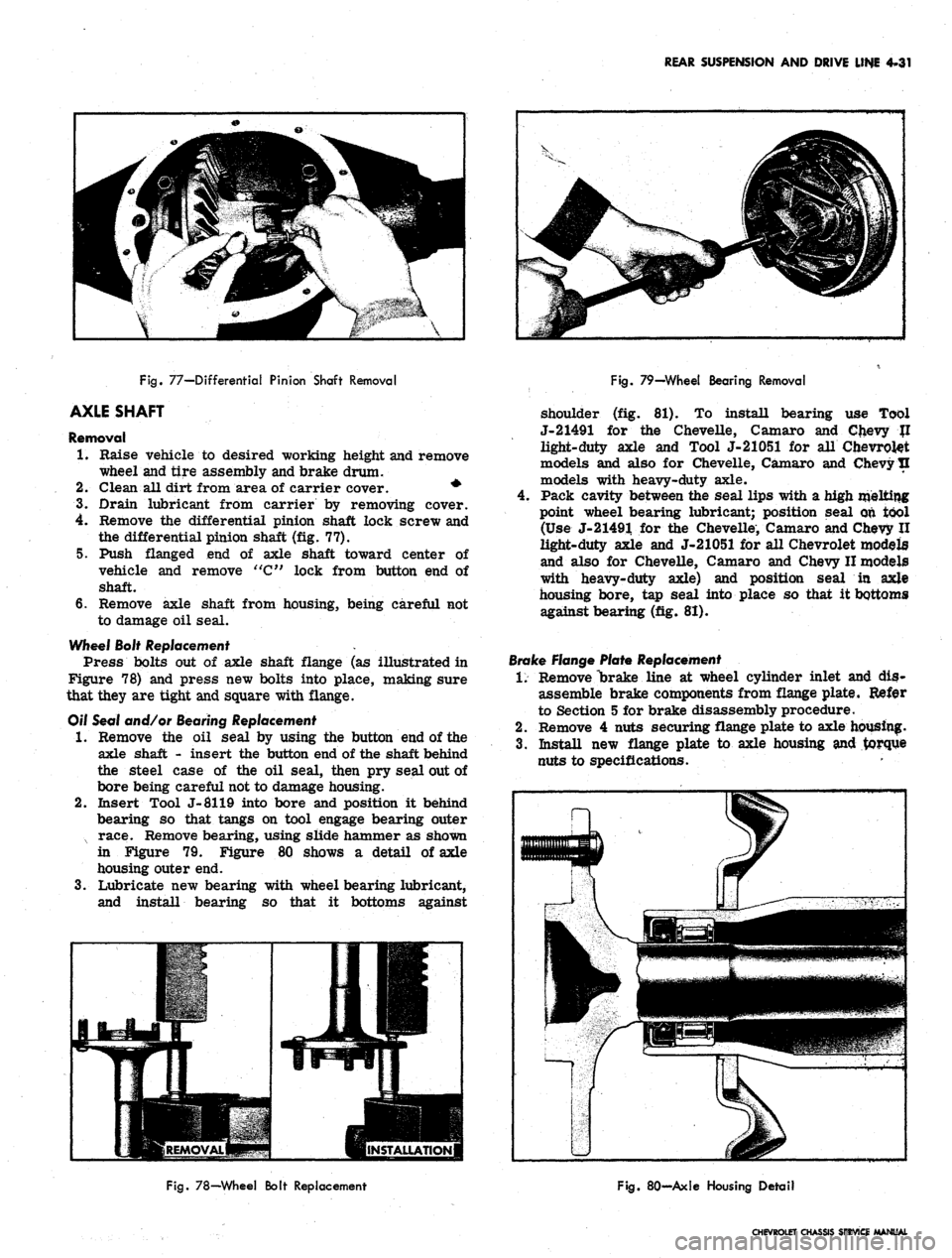
REAR SUSPENSION AND DRIVE LINE 4-31
Fig.
77—Differential Pinion Shaft Removal
AXLE SHAFT
Removal
1.
Raise vehicle to desired working height and remove
wheel and tire assembly and brake drum.
2.
Clean all dirt from area of carrier cover. *
3.
Drain lubricant from carrier by removing cover.
4.
Remove the differential pinion shaft lock screw and
the differential pinion shaft (fig. 77).
5. Push flanged end of axle shaft toward center of
vehicle and remove "C" lock from button end of
shaft.
6. Remove axle shaft from housing, being careful not
to damage oil seal.
Wheel Bolt Replacement .
Press bolts out of axle shaft flange (as illustrated in
Figure 78) and press new bolts into place, making sure
that they are tight and square with flange.
Off Seal and/or Bearing Replacement
•1.
Remove the oil seal by using the button end of the
axle shaft - insert the button end of the shaft behind
the steel case of the oil seal, then pry seal out of
bore being careful not to damage housing.
2.
Insert Tool J-8119 into bore and position it behind
bearing so that tangs on tool engage bearing outer
x race. Remove bearing, using slide hammer as shown
in Figure 79. Figure 80 shows a detail of axle
housing outer end.
3.
Lubricate new bearing with wheel bearing lubricant,
and install bearing so that it bottoms against
Fig.
79—Wheel Bearing Removal
shoulder (fig. 81). To install bearing use Tool
J-21491 for the Chevelle, Camaro and Chevy JI
light-duty axle and Tool J-21051 for all Chevrolet
models and also for Chevelle, Camaro and Chevy tl
models with heavy-duty axle.
Pack cavity between the seal lips with a high melting
point wheel bearing lubricant; position seal on tool
(Use J-21491 for the Chevelle, Camaro and Chevy II
light-duty axle and J-21051 for all Chevrolet models
and also for Chevelle, Camaro and Chevy II models
with heavy-duty axle) and position seal in axle
housing bore, tap seal into place so that it bottoms
against bearing (fig. 81).
Brake Flange Plate Replacement
1.
Remove "brake line at wheel cylinder inlet and dis-
assemble brake components from flange plate. Refer
to Section 5 for brake disassembly procedure.
2.
Remove 4 nuts securing flange plate to axle housing.
3.
Install new flange plate to axle housing and torque
nuts to specifications.
Fig.
78—Wheel Bolt Replacement
Fig.
80-Axle Housing Detail
CHEVROLET CHASSIS SERVICE MANUAL